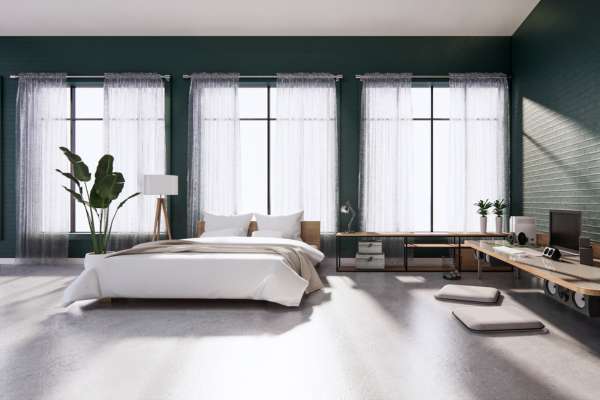Bedroom windows are more than mere openings; they are integral components of interior spaces, shaping the ambiance and functionality of a room. Defining the essence of bedroom window, they serve as conduits for natural light, enhancing occupants’ well-being and energy efficiency. The purpose of meticulously crafted bedroom windows designs extends beyond mere functionality; it embodies a fusion of aesthetic appeal and practicality, harmonizing with the overall interior design. The significance of well-designed bedroom windows lies in their ability to transform a space. Beyond framing views, they contribute to privacy, security, and environmental considerations, exemplifying a synergy of form and function that elevates the overall living experience. In essence, well-considered bedroom window designs are keystones in creating spaces that seamlessly blend comfort, style, and functionality.
Functionality and Practical Considerations
Bedroom windows play a crucial role in enhancing both functionality and practicality in a living space. Natural light, ventilation, and privacy are essential aspects to consider when designing bedroom window.
Natural light has a significant impact on health and well-being. It regulates sleep patterns, boosts mood, and enhances cognitive function. Adequate natural light in bedrooms promotes a sense of balance and reduces stress levels. Moreover, natural light contributes to energy efficiency by minimizing the need for artificial lighting.
Ventilation and airflow are paramount for maintaining indoor air quality. Properly ventilated bedrooms help prevent the buildup of stale air, humidity, and pollutants, which can lead to respiratory issues and allergies. Climate considerations should influence window design and placement. In warm climates, larger windows with awnings or casement styles can facilitate cross-ventilation, while in colder regions, double-glazed windows with energy-efficient coatings can retain heat.
Privacy and security are essential aspects of bedroom design. Window coverings, such as curtains, blinds, or shutters, provide privacy and control the amount of light entering the room. Additionally, safety features like window locks and security bars can deter intruders and enhance personal safety.
Aesthetics and Design Principles
Integration with Interior Design

- Coordination with Bedroom Theme: The choice of bedroom window design should seamlessly blend with the overall theme of the room. For instance, a traditional bedroom might feature bay or bow windows, while a modern bedroom could incorporate sleek casement or awning windows.
- Complementing Color Schemes: The color of the window frames should harmonize with the color palette of the bedroom. Neutral tones like white or cream create a sense of spaciousness, while bolder hues can add a touch of personality.
Window Styles and Configurations

- Traditional vs. Modern Designs: Traditional window styles, such as double-hung or sash windows, exude a classic charm that complements timeless décor. Modern window designs, like casement or awning windows, offer a sleek and contemporary aesthetic.
- Impact on Room Perception: The size and configuration of windows significantly impact the perception of space. Large windows can make a room feel more expansive and airy, while smaller windows can create a cozy and intimate atmosphere.
Materials and Finishes
- Wood, Vinyl, Aluminum, and Other Options: Window materials range from natural wood, which lends warmth and sophistication, to durable vinyl, known for its low maintenance and cost-effectiveness. Aluminum frames offer a sleek modern look and exceptional weather resistance.
- Texture and Surface Treatments: Beyond the base material, the texture and surface treatment of window frames can enhance the overall aesthetic. Smooth finishes create a clean and contemporary look, while textured or embossed finishes add visual interest and depth.
Popular Bedroom Window Designs

Bedroom windows play a vital role in enhancing the functionality, aesthetics, and overall ambiance of a sleeping space. Here’s an overview of popular bedroom window designs:
1. Single and Double-Hung Windows: These classic window styles feature sashes that slide vertically, Offering easy operation and ventilation control. Single-hung windows have one operable sash, While double-hung windows have two. They are versatile and can complement various bedroom styles.
2. Casement and Awning Windows: Casement windows hinge on one side and open outward, providing ample ventilation and unobstructed views. Awning windows hinge at the top and open outward, Offering excellent control over airflow and protection from rain. They are ideal for bedrooms that require controlled ventilation or privacy.
3. Bay and Bow Windows: Bay and bow windows project outward from the wall, creating a cozy nook for reading or relaxing. Bay windows feature three or more angled windows, while bow windows have a curved shape. They provide ample natural light and a captivating view of the surroundings.
4. Skylights and Clerestory Windows: Skylights and clerestory windows are strategically placed to maximize natural light from above. Skylights are installed in the roof, while clerestory windows are positioned high on the wall, often above eye level. They are ideal for illuminating dark corners or creating a sense of spaciousness.
5. Customized Solutions for Unique Spaces: For unique spaces or architectural challenges, customized window solutions can be tailored to fit specific needs. Shaped windows, Such as arched or circular windows, Can add a touch of elegance and architectural interest. Corner windows can maximize natural light in angled walls, While transom windows positioned above doorways provide additional ventilation and light.
Technological Advancements
Bedroom windows play a vital role in enhancing the functionality, Aesthetics, And overall ambiance of A sleeping space. Here’s an overview of popular bedroom window designs:
Smart Windows and Automated Systems

Integration with Home Automation: Smart windows seamlessly integrate with home automation systems, allowing for remote control and optimization of natural light, ventilation, and privacy. Sensors and actuators enable window to adjust automatically based on ambient conditions, occupancy, and personal preferences.
Energy-Efficient Technologies: Advanced glazing technologies, such as low-emissivity (low-E) coatings and suspended particle devices (SPDs), significantly reduce heat loss in winter and heat gain in summer, leading to substantial energy savings. Electrochromic window, which can tint or clear on demand, offer precise control over natural light and privacy.
Sustainable Materials and Eco-Friendly Designs
Impact on Carbon Footprint: The use of sustainable materials, such as recycled wood or aluminum, and energy-efficient manufacturing processes minimize the environmental impact of window production. Additionally, choosing renewable energy sources to power smart window systems further reduces the carbon footprint.
LEED Certification and Green Building Practices: Bedroom window can contribute to LEED (Leadership in Energy and Environmental Design) certification and green building standards by incorporating features such as high-performance glazing, passive ventilation strategies, and integration with renewable energy systems.
Budget Considerations
Bedroom window design involves careful consideration of both aesthetic and financial aspects. Here’s an overview of key budget considerations:
Cost of Materials and Installation
The cost of a bedroom window varies significantly depending on the type, size, material, and complexity of the installation. Single-hung window are generally the most economical option, while bay and bow window with high-performance glazing and automated systems can be more expensive. Installation costs also vary depending on labor rates and the specific requirements of each project.
Long-Term Maintenance and Durability
While the initial cost of a bedroom window is an important factor, long-term maintenance expenses should also be considered. Durable materials like aluminum or fiberglass require minimal maintenance, while wood window may require periodic refinishing or painting. Energy-efficient glazing and smart window systems can reduce energy costs over the lifespan of the window.
Return on Investment and Home Value
High-quality, energy-efficient bedroom window can enhance the value of a home by improving its curb appeal, increasing natural light, and reducing energy consumption. Additionally, smart window systems and automated controls can attract buyers seeking modern and technologically advanced features.
Case Studies
Showcase of Successfully Designed Bedrooms
Numerous case studies highlight the successful integration of bedroom window designs that enhance functionality, aesthetics, And overall well-being. These examples showcase creative approaches to natural light optimization, ventilation strategies, And privacy solutions, tailored to specific bedroom layouts and architectural styles.
Lessons Learned from Previous Projects
Analyzing successful and unsuccessful bedroom window design projects provides valuable lessons for future endeavors. Identifying common challenges and effective solutions can help architects, designers, And homeowners make informed decisions that maximize the benefits of bedroom windows.
Future Trends in Bedroom Window Designs
Emerging Technologies and Innovations
The future of bedroom window design is poised for significant advancements in technology and innovation. Smart windows with integrated sensors and actuators will continue to evolve, offering enhanced control over natural light, ventilation, And privacy. Additionally, self-cleaning and self-repairing window technologies are emerging, aiming to reduce maintenance and extend the lifespan of bedroom windows.
Evolving Design Preferences
Homeowners are increasingly seeking bedroom window designs that align with their evolving preferences for sustainability, wellness, and personalized comfort. Energy-efficient glazing, natural materials, And integrated home automation systems are gaining popularity, reflecting a growing desire for environmentally conscious and user-friendly solutions.
Sustainable Practices in Window Manufacturing
Sustainability is becoming a paramount consideration in the manufacturing of bedroom windows. The use of recycled materials, energy-efficient production processes, And reduced waste disposal practices are becoming increasingly prevalent. Additionally, manufacturers are exploring the use of renewable energy sources to power window production facilities, further minimizing the environmental impact.
What are some common bedroom window designs?
Common bedroom window designs include:
- Single Hung Windows: Featuring two sashes where only the bottom one is movable, single hung windows are simple and timeless.
- Double Hung Windows: Similar to single hung windows, double hung windows allow both the top and bottom sashes to open for increased ventilation.
- Casement Windows: Hinged on one side, casement windows swing outward with a crank mechanism, offering unobstructed views and excellent airflow control.
- Bay Windows: Bay windows protrude from the exterior wall, creating a cozy alcove inside the bedroom and offering expansive views and natural light.
What factors should I consider when choosing bedroom window designs?
When selecting bedroom window designs, consider factors such as:
- Aesthetics: Choose a design that complements the overall style and architecture of your bedroom.
- Functionality: Consider how you want the windows to operate—whether you prioritize ventilation, ease of use, or energy efficiency.
- Privacy: Depending on the location of your bedroom and your privacy preferences, select window designs that offer adequate privacy without compromising natural light.
- Natural Light: Determine how much natural light you want to let into the room and choose window designs accordingly.
How can I enhance the aesthetic appeal of bedroom windows?
You can enhance the aesthetic appeal of bedroom windows by:
- Adding Window Treatments: Install curtains, blinds, or shades that complement your bedroom decor and add visual interest.
- Incorporating Architectural Details: Consider adding window trim, moulding, or decorative grilles to enhance the architectural appeal of the windows.
- Choosing Decorative Hardware: Select stylish curtain rods, finials, and tiebacks to elevate the look of your window treatments.
- Integrating Outdoor Elements: Frame your bedroom windows with plants, flowers, or outdoor scenery to create a seamless connection between indoor and outdoor spaces.
Are there any energy-efficient bedroom window designs available?
Yes, there are several energy-efficient bedroom window designs, including:
- Double or Triple Pane Windows: These windows feature multiple layers of glass with insulating gas between them, providing better thermal insulation and energy efficiency.
- Low-E Coatings: Low-emissivity (Low-E) coatings are applied to window glass to reduce heat transfer and UV radiation, improving energy efficiency and indoor comfort.
- Insulated Frames: Opt for window frames made from materials such as vinyl, fiberglass, or wood-clad with insulation to minimize heat loss and enhance energy efficiency.
- Weather Stripping and Seals: Ensure proper weather stripping and seals around window frames to prevent air leakage and improve energy efficiency.
Conclusion
Meticulous attention to key considerations in bedroom window designs, including coordination with the theme, thoughtful choice of styles, materials, and finishes, enhances both functionality and aesthetics. The importance of professional consultation cannot be overstated, as experts navigate the nuanced world of design, ensuring optimal choices aligned with individual preferences and practical needs. Ultimately, well-designed bedroom windows transcend mere functionality, becoming integral elements that elevate the overall ambiance, fostering comfort, and visual appeal. The impact of a carefully crafted window design extends beyond the physical, shaping a harmonious and personalized sanctuary within the home.
